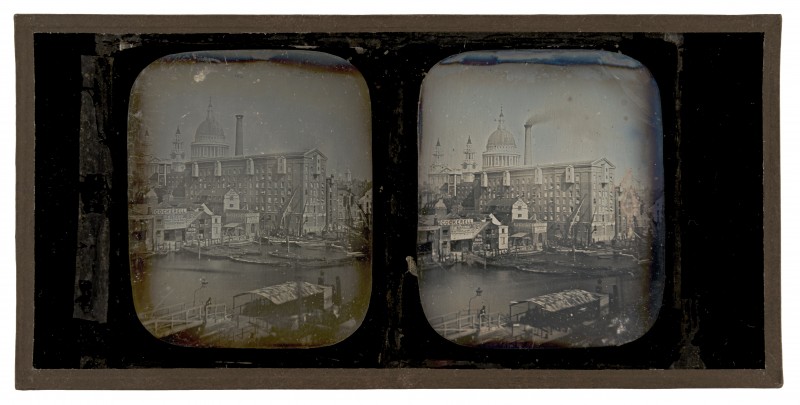London Metropolitan Archives is grateful to have received the support of the Friends of the National Libraries to purchase a rare stereoscopic daguerreotype of a City of London riverfront scene, 1851, attributed to Louis Jules Duboscq (1817-1886), the pioneering French photographer. Owing to its early date, content, format and overall rarity, the Duboscq stereoscopic daguerreotype notably enhances the photographic archive within London Metropolitan Archives’ History of London Collection, safeguarding and providing public access to an important piece of London history.
The daguerreotype is one of London Metropolitan Archives’ earliest photographs of a City of London scene and the only known stereoscopic daguerreotype of a City of London street scene. London Metropolitan Archives has scarcely a handful of photographs taken before 1860 and none that show the riverfront in the City pre-1860. The photograph is likely to have been taken from the site of Albion Mills, looking across the river towards the City with St Paul’s prominently rising above the warehouses and wharves on the riverside. This particular view is not well represented at this date by known prints and drawings and none approach the level of detail in the Duboscq stereoscopic daguerreotype. The daguerreotype provides an excellent topographical record bringing together industry, river transport and major City buildings, showing a stretch of wharves specialising in metals, including the Carron Iron Company which had one of the biggest warehouses in the City, shortly before this aspect of City activity started to disappear in favour of offices. The content is made vivid and engaging with river traffic and human activity captured with outstanding clarity and crispness of detail, enhanced by additional perspective and depth when viewed as a stereoscopic image. Some pre-1860 photographs of the Thames riverfront looking towards St Paul’s exist in other public collections, but none rival the content, detail and clarity of this image, or bring the scene to life in the same way.
The stereoscopic daguerreotype is composed of two exposures made sequentially rather than simultaneously. The presentation style is typical of Duboscq, and his initials appear on the verso. Viewing the stereoscopic daguerreotype as intended is possible using an adapted stereographic photograph viewer. However, owing to the fragile and rare nature of the item, primary public access will be via a digital image of the daguerreotype made available online through Collage - the London Picture Archive and on the London Metropolitan Archives Collections Catalogue digital image player, using software to replicate the stereoscopic effect. We are also looking forward to displaying the daguerreotype to the public, under secure and strictly controlled conditions for limited periods, in the City of London Heritage Gallery at Guildhall Art Gallery, which showcases the City’s treasures held in trust for the nation.
